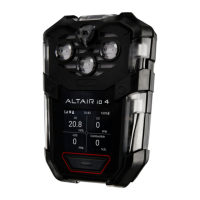When the combustible gas sensor reading reaches its maximum range, the device enters a locked alarm state to protect the
sensor, the sensor shuts down, and the user interface displays "overrange" in the combustible sensor tile. This state can be
reset by turning the device off and on in a fresh-air environment. Keep the device in the fresh air environment until sensor
readings have stabilized and then zero the sensors.
WARNING!
The minimum concentration of a combustible gas in air that can ignite is defined as the Lower Explosive Limit (LEL). A
combustible gas reading of “overrange" indicates that the atmosphere is above 100% LEL and an explosion hazard exists.
Do not use the device for prolonged periods in an atmosphere containing a concentration of fuel or solvent vapors that may
be greater than 10% LEL. Move away from the hazardous area immediately.
Failure to follow this warning can result in serious personal injury or death.
1.3.4 Physical Shock
If the device is subjected to a physical shock, complete the steps in Calibration.
1.3.5 Sensors
• Do not block sensor openings as this may cause inaccurate readings.
• Do not press on the face of the sensors, as this may damage them and cause erroneous readings.
• Do not use compressed air to clean the sensor holes, as the pressure may damage the sensors.
Allow sufficient time for device to display accurate reading. Response times vary based on the type of sensor being utilized.
NOTE: While the device can detect up to 30% oxygen in ambient air, it is approved for use only up to 21% oxygen in
hazardous locations.
1.3.6 Battery
Use only battery chargers made available by MSA for use with this device; other chargers may damage the battery pack and
the device. As the battery pack ages, there will be a reduction in usable device runtime.
1.3.7 Environmental Conditions
General
WARNING!
• Do not use the device to test for combustible or toxic gases in the following atmospheres as this may result in
erroneous readings:
○ Reducing atmospheres
○ Furnace stacks
○ Inert environments
○ Atmospheres containing combustible airborne mists/dusts.
• Do not use the device to test for toxic gases in oxygen-deficient (<19.5 % vol) or oxygen-rich (>20.8 % vol)
atmospheres, as this may result in erroneous readings.
• Do not use the device to test for combustible gases in atmospheres <10% vol oxygen, as this may result in erroneous
readings.
ALTAIR io 4 6
1 Safety Notices US

